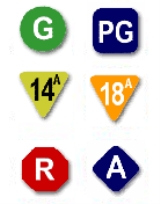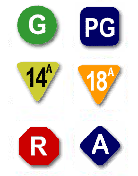
Canadian motion picture rating system
Encyclopedia
Motion picture ratings
in Canada
are mostly a provincial responsibility, and each province has its own legislation regarding exhibition and admission. For home video purposes, a single Canadian Home Video Rating System
rating consisting of an average of the participating provincial ratings is displayed on retail packages, although various provinces may have rules on display and sale, especially for the R and A categories.
There are currently six film classification offices rating movies in Canada, each an agency of a provincial government:
The province of Saskatchewan
has a Film and Video Classification Board
, but since 1997, it uses ratings provided by British Columbia. Newfoundland has no classification office or system. "Newfoundland theatres and video store operators are not required by legislation to use ratings, many theatres in Newfoundland use the classifications assigned by the Maritime Film Board in Nova Scotia". Of the three Canadian territories, Yukon
uses the BC ratings, while Nunavut
and the Northwest Territories
use Alberta ratings.
 In the past there was a wide range of rating categories and practices in the various provinces. However, the five rating systems outside Quebec now all use categories and logos derived from the Canadian Home Video Rating System
In the past there was a wide range of rating categories and practices in the various provinces. However, the five rating systems outside Quebec now all use categories and logos derived from the Canadian Home Video Rating System
. In general, the categories are:
This system was adopted by Alberta
and British Columbia
in 1997. Manitoba
and Ontario
adopted it in 2003 and the Maritimes
adopted it in April 2005.
There is also a common stock of Information Pieces ("Frightening Scenes", "Coarse Language", etc.), although different boards may have additional qualifiers.
Each board is responsible for assigning a rating to films, and while most movies will likely obtain the same rating, there can be differences. For instance, the film The Texas Chainsaw Massacre: The Beginning
was rated 18A in Alberta, British Columbia and Ontario while Manitoba and the Maritimes gave the film an R and Quebec gave the film a 16+ (it was R in the USA).
Canada receives much American advertising concerning film ratings. The American MPAA "R" rating is similar to the Canadian "18A" category (under-18s admitted with adult accompaniment). The Canadian "R" category would be similar to the American NC-17 rating.
 In Quebec
In Quebec
, the Régie du cinéma rates all films and videos. The Régie is a governmental agency overseen by the Quebec Ministry of Culture and Communications
. Its purview devolves from the Cinema Act (RSQ, C-18.1). Individual ratings and their rationales are publicly available online on the Régie's website http://www.rcq.qc.ca/RCQ221FilmClasseRecent.asp. The same classifications are used for television broadcasts.
The ratings and their optional complementary indications are as follows:
While not a classification per se, educational or pedagogical movies, sport and physical exercise programs, and promotional materials are exempt from classification.
The Régie does not cut sequences from movies; they are rated in the format provided by the production company. Nonetheless, the Régie has the authority to deny classification, in which case the movie cannot be distributed in any format in the province of Quebec. Such movies usually feature inhumane sexual exploitation.
was given an 18A rating, but was re-rated on appeal by the Motion Picture and Liquor Appeal Board to a 14A. This resulted in a record number of complaints to the British Columbia Film Classification Office from parents who felt the film should have been rated 18A. Many parents wrote letters to their local newspaper warning others that the film may be inappropriate for their fourteen-year-olds. Theatre owners complained about the inappropriate rating as well.
In British Columbia and Ontario, the Restricted rating is used almost exclusively for films which contain explicit sex. For this reason, with the adoption of the current rating system, many theatres refuse to book R rated films.
Motion picture rating system
A motion picture rating system is designated to classify films with regard to suitability for audiences in terms of issues such as sex, violence, substance abuse, profanity, impudence or other types of mature content...
in Canada
Canada
Canada is a North American country consisting of ten provinces and three territories. Located in the northern part of the continent, it extends from the Atlantic Ocean in the east to the Pacific Ocean in the west, and northward into the Arctic Ocean...
are mostly a provincial responsibility, and each province has its own legislation regarding exhibition and admission. For home video purposes, a single Canadian Home Video Rating System
Canadian Home Video Rating System
The Canadian Home Video Rating System is a voluntary rating classification system applied to home video products such as VHS and DVDs. It is administered by the Canadian Motion Picture Distributors Association and as such they appear on American home videos distributed in Canada and not genuine...
rating consisting of an average of the participating provincial ratings is displayed on retail packages, although various provinces may have rules on display and sale, especially for the R and A categories.
There are currently six film classification offices rating movies in Canada, each an agency of a provincial government:
- British Columbia Film Classification OfficeBritish Columbia Film Classification OfficeThe British Columbia Film Classification Office, part of the Business Practices and Consumer Protection Authority in the Canadian province of British Columbia under the Motion Picture Act of BC. The BCFCO ratings are also used by Saskatchewan under the terms of a bilateral agreement...
- Alberta Film Ratings
- Manitoba Film Classification BoardManitoba Film Classification BoardThe Manitoba Film Classification Board is part of the Ministry of Culture, Heritage and Tourism of the government of the Canadian province of Manitoba. The organization provides ratings information about film, videos, DVDs, computer and video games rented, sold or shown in Manitoba...
- Ontario Film Review BoardOntario Film Review BoardThe Ontario Film Review Board is an agency of the government of the Canadian province of Ontario that is responsible for that province's motion picture rating system...
- Régie du cinéma du QuébecRégie du cinéma (Quebec)The Régie du cinéma is a government agency responsible for the motion picture rating system within the Canadian province of Quebec. Its mandate is to classify and approve films for distribution to Quebec's movie theatres and home video outlets...
- Maritime Film Classification BoardMaritime Film Classification BoardThe Maritime Film Classification Board is a government organization responsible for reviewing films and granting film ratings in New Brunswick, Nova Scotia and Prince Edward Island ....
– run by the Nova Scotia Alcohol & Gaming Authority, it provides ratings for Nova ScotiaNova ScotiaNova Scotia is one of Canada's three Maritime provinces and is the most populous province in Atlantic Canada. The name of the province is Latin for "New Scotland," but "Nova Scotia" is the recognized, English-language name of the province. The provincial capital is Halifax. Nova Scotia is the...
, New BrunswickNew BrunswickNew Brunswick is one of Canada's three Maritime provinces and is the only province in the federation that is constitutionally bilingual . The provincial capital is Fredericton and Saint John is the most populous city. Greater Moncton is the largest Census Metropolitan Area...
and Prince Edward IslandPrince Edward IslandPrince Edward Island is a Canadian province consisting of an island of the same name, as well as other islands. The maritime province is the smallest in the nation in both land area and population...
(and some theatres in Newfoundland and LabradorNewfoundland and LabradorNewfoundland and Labrador is the easternmost province of Canada. Situated in the country's Atlantic region, it incorporates the island of Newfoundland and mainland Labrador with a combined area of . As of April 2011, the province's estimated population is 508,400...
though it is not compulsory).
The province of Saskatchewan
Saskatchewan
Saskatchewan is a prairie province in Canada, which has an area of . Saskatchewan is bordered on the west by Alberta, on the north by the Northwest Territories, on the east by Manitoba, and on the south by the U.S. states of Montana and North Dakota....
has a Film and Video Classification Board
Saskatchewan Film and Video Classification Board
The Saskatchewan Film and Video Classification Board is a board of the Saskatchewan Department of Justice responsible for providing film and video classification documents to movie theatres in the Canadian province of Saskatchewan...
, but since 1997, it uses ratings provided by British Columbia. Newfoundland has no classification office or system. "Newfoundland theatres and video store operators are not required by legislation to use ratings, many theatres in Newfoundland use the classifications assigned by the Maritime Film Board in Nova Scotia". Of the three Canadian territories, Yukon
Yukon
Yukon is the westernmost and smallest of Canada's three federal territories. It was named after the Yukon River. The word Yukon means "Great River" in Gwich’in....
uses the BC ratings, while Nunavut
Nunavut
Nunavut is the largest and newest federal territory of Canada; it was separated officially from the Northwest Territories on April 1, 1999, via the Nunavut Act and the Nunavut Land Claims Agreement Act, though the actual boundaries had been established in 1993...
and the Northwest Territories
Northwest Territories
The Northwest Territories is a federal territory of Canada.Located in northern Canada, the territory borders Canada's two other territories, Yukon to the west and Nunavut to the east, and three provinces: British Columbia to the southwest, and Alberta and Saskatchewan to the south...
use Alberta ratings.
Canadian ratings outside Quebec

Canadian Home Video Rating System
The Canadian Home Video Rating System is a voluntary rating classification system applied to home video products such as VHS and DVDs. It is administered by the Canadian Motion Picture Distributors Association and as such they appear on American home videos distributed in Canada and not genuine...
. In general, the categories are:
- G - General Audience - Suitable for all ages.
- PG - Parental Guidance - Parental guidance advised. There is no age restriction but some material may not be suitable for all children.
- 14A - 14 Accompaniment - Persons under 14 years of age must be accompanied by an adult.
- 18A - 18 Accompaniment - Persons under 18 years of age must be accompanied by an adult. In the MaritimesMaritimesThe Maritime provinces, also called the Maritimes or the Canadian Maritimes, is a region of Eastern Canada consisting of three provinces, New Brunswick, Nova Scotia, and Prince Edward Island. On the Atlantic coast, the Maritimes are a subregion of Atlantic Canada, which also includes the...
& ManitobaManitobaManitoba is a Canadian prairie province with an area of . The province has over 110,000 lakes and has a largely continental climate because of its flat topography. Agriculture, mostly concentrated in the fertile southern and western parts of the province, is vital to the province's economy; other...
, children under the age of 14 are prohibited from viewing the film. - R - Restricted - Admittance restricted to people 18 years of age or older.
- A - Adult - Admittance restricted to people 18 years of age or older. Sole purpose of the film is the portrayal of sexually explicit activity and/or explicit violence. In Alberta, the A category is used only for sexually explicit products. Manitoba and Ontario do not have this category, Manitoba uses a barcode labelling system for Adult home videos while Ontario has a Restricted-Adult Sex (RX) rating for home video products. In British Columbia, the A symbol is a red octagon rather than a blue diamond.
This system was adopted by Alberta
Alberta
Alberta is a province of Canada. It had an estimated population of 3.7 million in 2010 making it the most populous of Canada's three prairie provinces...
and British Columbia
British Columbia
British Columbia is the westernmost of Canada's provinces and is known for its natural beauty, as reflected in its Latin motto, Splendor sine occasu . Its name was chosen by Queen Victoria in 1858...
in 1997. Manitoba
Manitoba
Manitoba is a Canadian prairie province with an area of . The province has over 110,000 lakes and has a largely continental climate because of its flat topography. Agriculture, mostly concentrated in the fertile southern and western parts of the province, is vital to the province's economy; other...
and Ontario
Ontario
Ontario is a province of Canada, located in east-central Canada. It is Canada's most populous province and second largest in total area. It is home to the nation's most populous city, Toronto, and the nation's capital, Ottawa....
adopted it in 2003 and the Maritimes
Maritimes
The Maritime provinces, also called the Maritimes or the Canadian Maritimes, is a region of Eastern Canada consisting of three provinces, New Brunswick, Nova Scotia, and Prince Edward Island. On the Atlantic coast, the Maritimes are a subregion of Atlantic Canada, which also includes the...
adopted it in April 2005.
There is also a common stock of Information Pieces ("Frightening Scenes", "Coarse Language", etc.), although different boards may have additional qualifiers.
Each board is responsible for assigning a rating to films, and while most movies will likely obtain the same rating, there can be differences. For instance, the film The Texas Chainsaw Massacre: The Beginning
The Texas Chainsaw Massacre: The Beginning
The Texas Chainsaw Massacre: The Beginning, a 2006 American slasher film, functions as a prequel to the 2003 remake of the 1974 film The Texas Chain Saw Massacre. Directed by Jonathan Liebesman and co-produced by Kim Henkel and Tobe Hooper , the film went into release in North America on October 6,...
was rated 18A in Alberta, British Columbia and Ontario while Manitoba and the Maritimes gave the film an R and Quebec gave the film a 16+ (it was R in the USA).
Canada receives much American advertising concerning film ratings. The American MPAA "R" rating is similar to the Canadian "18A" category (under-18s admitted with adult accompaniment). The Canadian "R" category would be similar to the American NC-17 rating.
Quebec system

Quebec
Quebec or is a province in east-central Canada. It is the only Canadian province with a predominantly French-speaking population and the only one whose sole official language is French at the provincial level....
, the Régie du cinéma rates all films and videos. The Régie is a governmental agency overseen by the Quebec Ministry of Culture and Communications
Ministry of Culture and Communications (Quebec)
Minister of Culture and Communications is responsible for promoting and protecting the culture in the province of Quebec .-External links:...
. Its purview devolves from the Cinema Act (RSQ, C-18.1). Individual ratings and their rationales are publicly available online on the Régie's website http://www.rcq.qc.ca/RCQ221FilmClasseRecent.asp. The same classifications are used for television broadcasts.
The ratings and their optional complementary indications are as follows:
- G Visa général (General Rating): May be viewed, rented or purchased by persons of all ages.
- 13+ 13 ans et plus (13 years and over): May be viewed, rented or purchased by children 13 years of age or over. Children under 13 may be admitted only if accompanied by an adult.
- 16+ 16 ans et plus (16 years and over): May be viewed, rented or purchased by children 16 years of age or over.
- 18+ 18 ans et plus (18 years and over): May be viewed, rented or purchased by adults 18 years of age or over.
While not a classification per se, educational or pedagogical movies, sport and physical exercise programs, and promotional materials are exempt from classification.
The Régie does not cut sequences from movies; they are rated in the format provided by the production company. Nonetheless, the Régie has the authority to deny classification, in which case the movie cannot be distributed in any format in the province of Quebec. Such movies usually feature inhumane sexual exploitation.
Criticism
In certain provinces in Canada, the rating system has come under criticism as being too lenient. For example, in British Columbia, the film Scary MovieScary Movie
Scary Movie is a 2000 comedy-parody film directed by Keenen Ivory Wayans, as part of Warner Bros. Entertainment. It is an American dark comedy which heavily parodies the horror, slasher, and mystery genres...
was given an 18A rating, but was re-rated on appeal by the Motion Picture and Liquor Appeal Board to a 14A. This resulted in a record number of complaints to the British Columbia Film Classification Office from parents who felt the film should have been rated 18A. Many parents wrote letters to their local newspaper warning others that the film may be inappropriate for their fourteen-year-olds. Theatre owners complained about the inappropriate rating as well.
In British Columbia and Ontario, the Restricted rating is used almost exclusively for films which contain explicit sex. For this reason, with the adoption of the current rating system, many theatres refuse to book R rated films.
See also
- Motion Picture Association of America film rating system
- Entertainment Software Ratings Board, the video game equivalent used in Canada and the United States

